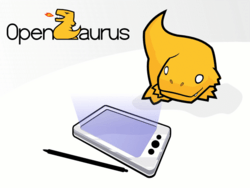OpenZaurus facts for kids
 |
|
| OS family | Linux (Unix-like) |
|---|---|
| Source model | Open source |
| Latest stable release | 3.5.4.1 / July 6, 2006 |
| Latest unstable release | 3.5.4.2-rc2 / September 2, 2006 |
| Package manager | ipkg |
| Supported platforms | ARM |
| Kernel type | Monolithic Linux kernel |
| Default user interface | Console, X Window System, GPE, OPIE |
| License | GNU GPL |
| Official website | OFFLINE |
OpenZaurus was a special computer program, called an operating system. It was made for a small handheld device called the Sharp Zaurus. Think of it like the Windows or macOS on your computer, but for a tiny, portable device. OpenZaurus is no longer used today.
Contents
The Story of OpenZaurus
OpenZaurus started as a changed version of the Sharp Zaurus's original software. This original software was called the SharpROM. Developers wanted to make the Zaurus's system more open and easier to work with. So, they fixed problems, added new programs, and removed some parts to make it better for them.
Later, the OpenZaurus project changed completely. It was rebuilt from scratch, using a system called Debian. This made OpenZaurus similar to other special Linux systems for small devices. OpenZaurus made it easy for users to create their own custom versions of the software. The work done by OpenZaurus and other similar projects eventually joined forces. They became part of the OpenEmbedded Project. This project now provides a common way to build software for many different small devices.
Different Versions of OpenZaurus
You could get OpenZaurus in a few different forms. Each form was designed for different needs.
- Bootstrap: This was a very basic version. It only had the most important parts to make the device work. You could connect it to the internet using SSH, Wi-Fi, Bluetooth, or USB. This version was good for starting to build a bigger system.
- GPE: This version included everything from the Bootstrap version. It also added a graphical user interface (GUI) called GPE Palmtop Environment. A GUI lets you use icons and menus instead of just typing commands.
- OPIE: Like GPE, this version also included the Bootstrap parts. But instead of GPE, it used a different graphical interface called OPIE Palmtop Integrated Environment.
What Happened to OpenZaurus?
On April 26, 2007, the OpenZaurus team announced that the project was ending. The people who worked on OpenZaurus decided to focus their efforts on a new project. This new project is called the Ångström distribution. It is also for embedded systems, which are small computers built into other devices.
Other Similar Systems
- Palm OS
- Pocket PC
- Windows Mobile

